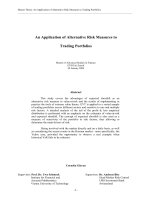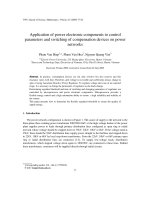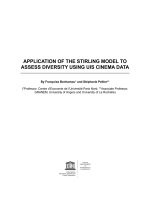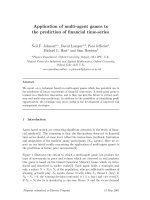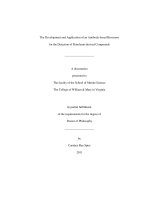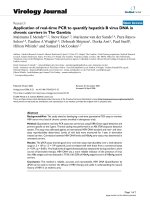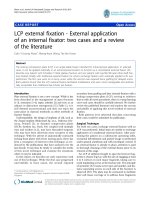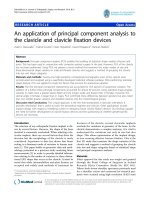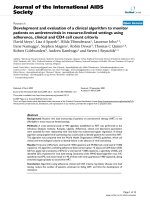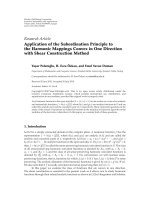Application of an optimisation algorithm to configure an internal fixation device
Bạn đang xem bản rút gọn của tài liệu. Xem và tải ngay bản đầy đủ của tài liệu tại đây (2.05 MB, 108 trang )
Application of an Optimisation
Algorithm to Configure an Internal
Fixation Device
Salma Ibrahim, B.E. (Medical)
Submitted for the award of the degree of Master of
Engineering in School of Engineering Systems of the faculty
for Built Environment and Engineering, Queensland
University of Technology
2010
Optimisation of an Internal Fixation Device
Keywords
Biomechanics, Optimisation Algorithm, Finite Element Modelling,
Fracture Healing, Internal Fracture Fixation
i
Optimisation of an Internal Fixation Device
Abstract
Project Title:
Application of an optimisation algorithm to configure an internal fixation device
Author:
Salma Ibrahim
Supervisors:
Dr. Sanjay Mishra (Primary)
Dr. Gongfa Chen (Secondary)
Fractures of long bones are sometimes treated using various types of fracture
fixation devices including internal plate fixators. These are specialised plates which
are used to bridge the fracture gap(s) whilst anatomically aligning the bone
fragments. The plate is secured in position by screws. The aim of such a device is to
support and promote the natural healing of the bone.
When using an internal fixation device, it is necessary for the clinician to decide
upon many parameters, for example, the type of plate and where to position it; how
many and where to position the screws. While there have been a number of
experimental and computational studies conducted regarding the configuration of
screws in the literature, there is still inadequate information available concerning
the influence of screw configuration on fracture healing.
Because screw configuration influences the amount of flexibility at the area of
fracture, it has a direct influence on the fracture healing process. Therefore, it is
important that the chosen screw configuration does not inhibit the healing process.
In addition to the impact on the fracture healing process, screw configuration plays
an important role in the distribution of stresses in the plate due to the applied loads.
A plate that experiences high stresses is prone to early failure. Hence, the screw
configuration used should not encourage the occurrence of high stresses.
This project develops a computational program in Fortran programming language to
perform mathematical optimisation to determine the screw configuration of an
ii
Optimisation of an Internal Fixation Device
internal fixation device within constraints of interfragmentary movement by
minimising the corresponding stress in the plate. Thus, the optimal solution suggests
the positioning and number of screws which satisfies the predefined constraints of
interfragmentary
movements.
For
a
set
of
screw
configurations
the interfragmentary displacement and the stress occurring in the plate were
calculated by the Finite Element Method. The screw configurations were iteratively
changed and each time the corresponding interfragmentary displacements were
compared with predefined constraints. Additionally, the corresponding stress was
compared with the previously calculated stress value to determine if there was a
reduction. These processes were continued until an optimal solution was achieved.
The optimisation program has been shown to successfully predict the optimal screw
configuration in two cases. The first case was a simplified bone construct whereby
the screw configuration solution was comparable with those recommended in
biomechanical literature. The second case was a femoral construct, of which the
resultant screw configuration was shown to be similar to those used in clinical cases.
The optimisation method and programming developed in this study has shown that
it has potential to be used for further investigations with the improvement of
optimisation criteria and the efficiency of the program.
iii
Optimisation of an Internal Fixation Device
Table of Contents
Keywords ........................................................................................................................................................... i
Abstract ............................................................................................................................................................ ii
Table of Contents ........................................................................................................................................iv
Figures and Tables ................................................................................................................................... vii
Abbreviations used in the text .............................................................................................................. ix
Statement of Originality............................................................................................................................ x
Acknowledgements.................................................................................................................................... xi
1.
Introduction ......................................................................................................................................... 1
1.1.
Background .................................................................................................................................. 1
1.2.
Problem .......................................................................................................................................... 1
1.3.
Aims ................................................................................................................................................. 3
1.4.
Significance of the Study ........................................................................................................ 3
1.5.
Outline of Thesis ........................................................................................................................ 4
2. Literature Review and Background ............................................................................................... 6
2.1. Treatment of Long Bone Fractures ........................................................................................... 6
2.1.1. Internal Fixators .................................................................................................................... 7
2.1.2. Fracture Healing .................................................................................................................... 9
2.2. Factors Influencing the Strength of the Fixation Construct and Bone Healing11
2.2.1. Stiffness of Fracture Fixation ........................................................................................ 12
2.2.2. Physical Conditions for Fracture Healing ............................................................... 12
2.3. Influence of Working Length and Fracture Gap on Fixation Stability ............... 14
2.4. Screw Positioning ....................................................................................................................... 18
2.5. Limitations of previous studies ............................................................................................ 19
2.6. Summary ......................................................................................................................................... 20
3. Methods - Optimisation .................................................................................................................... 21
3.1. Mathematical Definition of Optimisation ........................................................................ 21
3.2. Types of Optimisation Problems and How to Solve Them ...................................... 22
3.2.1. Constrained/ Unconstrained Optimisation Problems ...................................... 22
3.2.2. Multi-modal Optimisation .............................................................................................. 24
3.2.3. Deterministic Methods .................................................................................................... 26
iv
Optimisation of an Internal Fixation Device
Powell s method ...........................................................................................................................27
3.3.1. Conjugate Directions .........................................................................................................27
3.3.2. The Algorithm.......................................................................................................................28
3.3.3. Golden Section Search Search in One Direction. ..............................................32
3.4. Use of optimisation methods in medical engineering................................................33
3.5. Optimisation of Screw Configuration in Internal Fixators ......................................35
3.5.1. Objectives and Constraints.............................................................................................35
3.5.2. Optimisation Criteria ........................................................................................................36
3.5.3.
Objective Function ........................................................................................................37
3.5.4.
Calculation of Function Value (with the use of FE method)......................37
3.5.5.
Data Transfer ...................................................................................................................41
4. Results........................................................................................................................................................44
4.1. Case 1: Simplified Model ..........................................................................................................44
4.1.1. Bone Geometry.....................................................................................................................44
4.1.2. Plate and Screws Geometry ...........................................................................................44
4.1.3. Material Properties ............................................................................................................46
4.1.4. Boundary and Loading Conditions .............................................................................47
4.1.5. Variables to be Optimised ...............................................................................................47
4.1.6. Selection of Values for Optimisation Criteria ........................................................47
4.1.7. Solution for Simplified Model .......................................................................................51
4.2. Case 2: Clinical Model ................................................................................................................55
4.2.1. Clinical Cases .........................................................................................................................55
4.2.2. Additional Cases ..................................................................................................................57
4.2.3. Femoral Bone Geometry..................................................................................................57
4.2.4. Plate and Screws of Femoral Construct ...................................................................58
4.2.5. Assembly .................................................................................................................................58
4.2.6. Materials..................................................................................................................................58
4.2.7. Loading and Boundary Conditions .............................................................................59
4.2.8. Variables to be Optimised ...............................................................................................59
4.2.9. Selection of Optimisation Criteria...............................................................................62
4.2.10. Solution .................................................................................................................................64
5.
Discussion ...........................................................................................................................................72
5.1.
Limitations of this Study......................................................................................................74
v
Optimisation of an Internal Fixation Device
5.2. Improvements to the Model................................................................................................... 76
5.3.
Improvement to the Optimisation Criteria ................................................................ 77
5.4.
Future Work - Improvements to the Optimisation Method............................... 79
6.
Conclusions ........................................................................................................................................ 81
7.
References .......................................................................................................................................... 83
Appendix ....................................................................................................................................................... 87
Optimisation program including subroutines in Fortran................................................. 87
Python script file to read out values from FEA...................................................................... 94
vi
Optimisation of an Internal Fixation Device
Figures and Tables
Figure 1 LCP-combination hole allowing conventional plate fixation as well as application of
locked screws (Source: (Perren, 2002)).................................................................................................. 7
Figure 2 Internal fixator used with locked screws. Fixator barely touches the bone as screws
allow reliable maintenance of the initial distance between internal fixator and bone
(Source: (Perren, 2002)). ................................................................................................................................ 8
Figure 3 Direct healing from osteotomy of sheep tibia with compression stabilisation. The
bone fragments are close and compressed and there is no displacement at the site of
the osteotomy. The shape of the osteones do not change when crossing the fracture.
(Source: Perren, 2002) ..................................................................................................................................... 9
Figure 4 Histological images of secondary fracture healing in bone (Source: J. Bone Miner.
Res., 16, 1004 1014, 2001). ...................................................................................................................... 11
Figure 5 Left: X-ray image of femoral fracture in 35 year old male with flexible fixation.
Right: X-ray image 4 months after fixation, showing obvious signs of callus growth.
Source: (Chen et al., 2010). .......................................................................................................................... 15
Figure 6 Seven week postoperative x-ray showing fracture fixation by placing several
locking screws in main fragments. The screw holes were occupied adjacent to the
fracture site resulting in high stress concentrations occurring in that section of the
plate. Source: (Sommer et al., 2003) ...................................................................................................... 16
Figure 7 Example of contours of an objective function (Source: Rao, S. S.; Engineering
Optimization-Theory and Practice, 3rd Ed. 1996, pp.363) ........................................................ 23
Figure 8 A multi-modal function. Source: (Singh et al., 2006) ............................................................. 25
Figure 9 Conjugate Direction (Source: Rao, S. S.; Engineering Optimization-Theory and
Practice, 3rd Ed. 1996, pp.363) ................................................................................................................. 28
Figure 10 Progress of Powell's Method (Source: Rao, S. S.; Engineering Optimization-Theory
and Practice, 3rd Ed. 1996, pp.363) ....................................................................................................... 31
Figure 11 Illustration of Golden Section Search .......................................................................................... 32
Figure 12 Showing data transfer between different software packages ........................................ 41
Figure 13 Screw positions (variables) to be optimised in the simplified model........................ 45
Figure 14 Mesh of the simplified cylindrical model .................................................................................. 47
Figure 15 (a) Rigid simplified construct, (b) flexible simplified construct ................................... 48
Figure 16 Nodes used to calculate displacements ..................................................................................... 49
Figure 17 Showing sharp edge (a cause of FE errors) in screw holes of the locking
compression plate ............................................................................................................................................ 51
Figure 18 Optimised solution for simplified model................................................................................... 51
Figure 19 Maximum principal stress distribution in cylindrical construct .................................. 52
Figure 20 (a) treatment of transverse fracture of 73 yr old patient (b) X-ray image showing
failure of implant 7 weeks post-op (c) treatment of fracture of a 35 year old male (d) Xray showing successful healing of fracture ......................................................................................... 56
Figure 21 Shows 4 fixed screws (black, 2 at each end of plate) and 6 screw positions
(yellow) to be optimised............................................................................................................................... 60
Figure 22 (a) Fracture healing in patient after 4 months using a flexible screw configuration.
(Source: J Eng Med. Chen et al, 2010); (b) Simulation of the same combination used for
FE analysis ........................................................................................................................................................... 61
vii
Optimisation of an Internal Fixation Device
Figure 23 (a) flexible construct, (b) rigid construct .................................................................................. 63
Figure 24 (a) Screw configuration used in clinical case from Chen et al (2010); (b) Resultant
screw configuration from optimisation algorithm .......................................................................... 65
Figure 25 Maximum principal stress distribution in femoral construct of the optimised
solution .................................................................................................................................................................. 67
Figure 26 (a) Flexible construct, (b) Construct with more rigidity due to shorter working
length ...................................................................................................................................................................... 68
Figure 27 Some screw configurations that were tried and tested by the optimisation
algorithm. White represents screws that were chosen by the optimisation algorithm
that were tested. Black represents screws that were fixed throughout the optimisation
process. .................................................................................................................................................................. 73
Figure 28 Illustration of concept of local versus global minimisation ............................................. 75
Figure
Boundaries for optimal healing in the sheep model s that lead to timely healing
(Source: Epari et al, 2007) ........................................................................................................................... 78
Table 1Interfragmentary displacement and maximum principal stress for the most rigid and
the most flexible cylindrical models ....................................................................................................... 49
Table 2 Comparison of displacements from solution and those from constraints for the
cylindrical model .............................................................................................................................................. 52
Table 3 Comparison of displacement and stress resulting from flexible and rigid construct
with that of solution construct for the cylindrical model ............................................................ 53
Table 4 Shear, axial displacement and stress in plate resulting from the configuration from
Chen et al (2010)............................................................................................................................................... 62
Table 5 Interfragmentary displacement and maximum principal stress for most rigid and
most flexible femur models ......................................................................................................................... 64
Table 6 Comparison of displacements from solution and those from constraints .................... 67
Table 7 Comparison of displacement and stress resulting from flexible and rigid construct
with that of solution construct .................................................................................................................. 68
Table 8 Axial and shear displacement resulting from the flexible and rigid constructs from
Figure 27 (a) and (b)....................................................................................................................................... 69
Table 9 Axial and shear displacements resulting from the removal of pairs of screws from
each side of the fracture gap from the all screws in place construct ..................................... 70
Table 10 Comparison of displacement and stress from optimised solution with that from
screw configuration used in clinical case from Chen et al (2010) .......................................... 70
viii
Optimisation of an Internal Fixation Device
Abbreviations used in the text
FE = Finite Element
LCP = Locking Compression Plate
LISS = Less Invasive Stabilising System
DCP = Dynamic Compression Plate
TSP = Travelling Salesman Problem
ix
Optimisation of an Internal Fixation Device
Statement of Originality
The work contained in this thesis has not been previously submitted for a degree or
diploma at any other higher education institution. To the best of my knowledge and
belief, the thesis contains no material previously published or written by another
person except where due reference is made
Signature: ________________________________________
Date: ______________________________________________
x
Optimisation of an Internal Fixation Device
Acknowledgements
I would like to thank my supervisors, Dr. Gongfa Chen and Dr. Sanjay Mishra for
their help, support and guidance throughout this study. I am grateful to the trauma
team at IHBI, my fellow colleagues and friends making the research environment
more enjoyable, and Mr. Mark Barry and the HPC team for their assistance with the
supercomputer.
xi
Optimisation of an Internal Fixation Device
1. Introduction
1.1. Background
Severe trauma to the extremities is the leading cause of disability during the wageearning period of life. Bone fractures cost the Australian healthcare system one
billion dollars a year. In addition to this cost, the functional loss of limbs impact
significantly on the patients quality of life Studying the impact of fixation devices
on bone healing will fill knowledge gaps and enhance the usefulness of these
devices for the purpose of fracture healing. This will ultimately reduce costs and
improve quality of life for the patient.
High-energy collisions with long bones often result in fractures with significant
misalignments of bone fragments. In these cases it is difficult for the body to pursue
its natural healing course in order to produce a successful healing outcome. For
these instances, surgical fracture treatment is usually required. There are a number
of fracture fixation devices available, including external fixators, intermedullary
nails and internal plate fixators. The need to use any one of them depends on the
physical characteristics of the trauma. Ultimately, the purpose of using these
fixation devices is to restore functionality to the bone and limb.
1.2. Problem
To promote a successful fracture healing outcome, it is necessary to correctly
configure the fracture fixation device according to the physical condition of the
trauma. Some of the configuration parameters that should be decided upon are the
1
Optimisation of an Internal Fixation Device
type of plate, including the length; where to position the plate; how many and
where to position the screws. Each parameter contributes to the progress and
outcome of the healing fracture. If the fixation device is improperly configured, it
can hinder the fracture healing process, resulting in revision surgery. This
increases the burden of the healthcare system and decreases quality of life for the
patient involved.
In internal plate fixation, the screw configuration is one of the vital parameters
decided upon by the orthopaedic surgeon. If the surgeon uses too many screws, the
plate may prematurely fail during treatment of the fracture, in which case, revision
surgery may be required. Furthermore, there may not be sufficient motion at the
fracture gap required for healing. At the other extreme, in the case of using too few
screws, the stress in the plate is decreased at the expense of an increased amount
of motion of the bone fragments. Excess movement causes further complications,
such as a delayed or non-union of the bone fragments. Therefore, the goal is to find
the best screw configurations to be used following the requirement that the
fracture successfully heals, while the implant does not fail.
Previous studies (Tornkvist et al, 1996; Stoffel et al, 2003; Duda et al, 2002) have
used mainly experimental techniques and some finite element analyses to evaluate
the strength and stiffness of certain screw configurations, and to identify trends in
screw placement. The approach taken in this study is to optimise the screw
configuration of the fixation device using mathematical programming, with the
added advantage of simultaneously creating optimum conditions for healing.
Mathematical optimisation techniques have been used successfully for numerous
applications in various fields of engineering. However, they have not been applied
to the topic of fracture healing in the biomedical field. In this study, mathematical
programming is utilised to ultimately optimise the screw configuration with
respect to bone fragment movement constraints in certain directions, ensuring that
the stress in the plate is minimised.
2
Optimisation of an Internal Fixation Device
1.3. Aims
There are two main aims of this study.
1. Develop an optimisation tool.
This involves creating an interface between various softwares used to
develop the optimisation process. Finite element (FE) software is used to do
numerical analysis on a computational fracture model while a Python
program is used to extract information from the FE output database. The
mathematical
optimisation
algorithm
itself is written
in
Fortran
programming language. It was used to create the software interface.
2. Investigate the potential for the optimisation tool to solve the clinical
problem.
Apply the developed optimisation process to various cases to determine the
optimal screw configuration that enhances bone healing and avoids
mechanical failure of the plate in internal fixation for a particular fracture.
1.4. Significance of the Study
By defining the requirements for timely fracture healing, fracture fixation devices
may be configured in a manner in which they support healing conditions.
In the field of fracture healing, researchers (Epari et al, 2007; Goodship and
Kenwright, 1985) have strived to define the precise conditions required for timely
fracture healing. Goodship and Kenwright applied rigid fixation to one group of
3
Optimisation of an Internal Fixation Device
fractures and controlled axial movement in another group in vivo, in an attempt to
determine the optimal parameters for fracture healing. The results showed that
controlled micro-movement significantly improved healing. Epari et al looked at
the association between strength of healed bones to the stiffness of their respective
fracture fixation configurations. It was found that optimising axial stability and
limiting shear movements was required for timely healing.
In a recent paper, Chen et al (2010) biomechanically analysed two cases presented
to them from the clinical environment from different orthopaedic surgeons. The
internal fixation device that was configured in a rigid manner failed due to a fatigue
fracture and did not heal. The other case which was configured in a more flexible
manner did heal. Although there has been progress in this research field over many
decades, there is still the knowledge gap of selecting the best screw configuration
for a fracture fixation device in a given situation. This project aims to further
research in this area using optimisation mathematical programming.
1.5. Outline of Thesis
Chapter 2 will discuss fixation stability regarding internal fixation devices and
fracture healing. Fracture fixator parameters such as screw positioning and
numbers, and their influence on the strength of the fixator and the stress in the
plate, as well as the influence of the size of the fracture gap will be examined.
Chapter 3 will provide a detailed explanation of the how the mathematical
programming method is interfaced with results from the FE calculations for
optimisation of the screw configuration.
Chapter 4 is the results section which addresses two computational model cases to
which the optimisation method was applied. One is a simplified cylindrical case,
while the other is a femoral clinical case.
4
Optimisation of an Internal Fixation Device
Chapter 5 holds a discussion of various aspects of the optimisation method used
and improvements are suggested.
It should be noted that this thesis focuses on the method of optimisation used
rather than the final application.
5
Optimisation of an Internal Fixation Device
2. Literature Review and Background
Severe trauma to the extremities is the leading cause of disability during the wage
earning period of life (BJD, 1998). Over 150,000 Australians are hospitalised with
fractures each year (Welfare, 2006). The socio-economic burden of fractures is
substantial. Loss of working capacity represents over 60% of the total cost of bone
fractures, while less than 20% is due to the direct cost of medical treatment.
Optimal outcomes, therefore, require not only solid bone union but also early and
complete recovery of limb function.
This chapter describes the process of fracture healing and the mechanical
conditions necessary for healing. Fixation stability is vital for fracture healing and is
characterised by the mechanical configuration of the fracture fixator being used.
Although there are numerous mechanical parameters involved in fracture fixation,
this review will focus on one of the mechanical aspects, i.e., screw configurations
and its importance in fracture healing.
2.1. Treatment of Long Bone Fractures
A fracture occurs when a high amount of energy is absorbed by the bone until
failure occurs (Brighton, 1984). For these types of fractures, surgery is often
necessary. There are three main types of fracture fixation treatments involving
surgery. As previously mentioned, they are external fixation, intramedullary nailing
and internal fixation. All fixation devices are designed for the restoration of limb
function, anatomical reduction by stabilisation of bone fragments and promotion of
bone healing.
Internal fixators, i.e. plates and screws, are common in the treatment of shaft
fractures up to the metaphyseal area (Ruedi et al., 2001). A failure rate of 7% is
reported with plate failure, screw loosening or breakage being the causes of failure
(Riemer et al., 1992). In the incidence of failure, due to a large range of possible
6
Optimisation of an Internal Fixation Device
complications, revision surgery is often necessary which decreases the quality of
life of the patient, and increases costs to the healthcare system.
2.1.1. Internal Fixators
Locking plates are internal fracture fixation devices that have been designed to
allow maximal vascularisation to the damaged bones and achieve a minimal
implant-bone interface. Two methods of treatment are available using the Locking
Compression Plate (LCP). This is made possible by the screw combination holes in
which part of the hole allows the fitting of a locked screw, whereas the other part of
the hole allows screws to be positioned at different angles (Figure 1).
Figure 1 LCP-combination hole allowing conventional plate fixation as well as application
of locked screws (Source: (Perren, 2002)).
In the compression treatment method, as in conventional plating, anatomic
reconstruction and absolute stability may be achieved. The other treatment method
is called locked splinting, in which the LCP is used to simply bridge the fracture gap,
leaving the defected zone untouched. This method is ideal for the fixation of
comminuted, diaphyseal and metaphyseal fractures (Wagner et al., 2007) (Figure
2). The LCP allows the combination of the compression method and the locked
splinting method.
7
Optimisation of an Internal Fixation Device
Figure 2 Internal fixator used with locked screws. Fixator barely touches the bone as
screws allow reliable maintenance of the initial distance between internal fixator and bone
(Source: (Perren, 2002)).
With a variety of plates and types of screws available for security of the fracture,
and the large number of different configurations possible, the orthopaedic surgeon,
based on his experience, has to decide upon many mechanical factors regarding
configuration, whilst taking into consideration the biological conditions of the
fracture. The determinants of the fixation method are: which type of plate,
including the length; where to position the plate; how many and where to position
the screws (Wagner et al., 2007).
Chen et al (2010) has undertaken a FE study of comparing the influence of different
numbers of screws on plate failure. The configurations of the screws that were
compared were those that had been used in a clinical case. One was a flexible
fixture (6 screws out of a possible 14) in which successful healing occurred. The
other was a rigid fixture (12 screws out of a possible 14) in which plate failure
occurred without healing of the fracture. In the FE study, it was found that under
physiological loading, the plate that was rigidly fixed experienced significantly
higher stresses than the one fixed in a more flexible manner. In the fatigue analysis
it was found that the plate under rigid fixation fractured at 20 days after surgery,
whilst the plate under flexible fixation was able to endure 2000 days. This study
8
Optimisation of an Internal Fixation Device
has highlighted the major impact of screw configuration for fixation stability for
fracture healing as well as its influence on plate failure.
It is important to describe the fracture healing process to better understand the
implications of mechanical stimulus due to fracture fixation.
2.1.2. Fracture Healing
Naturally, the body has two ways of healing bone fractures. One is primary healing,
which involves direct compression across the bone fragments. In this case there is
no displacement of fragments and there is absolute stability of fixation. Osteones
(functional unit of compact/cortical bone) are able to grow across the bone
fragments. The disadvantage of this process is that the fracture takes an extended
period of time to heal compared to the secondary healing.
Figure 3 Direct healing from osteotomy of sheep tibia with compression stabilisation. The
bone fragments are close and compressed and there is no displacement at the site of the
osteotomy. The shape of the osteones do not change when crossing the fracture. (Source:
Perren, 2002)
The other type of healing is secondary healing, which involves the formation of a
callus around the fracture site. This usually occurs when there is high impact
trauma to the bone, and there is extensive soft tissue damage. Healing of a fracture
9
Optimisation of an Internal Fixation Device
of this calibre involves a number of stages and may take weeks until the formation
of bone is observed.
In such an open fracture, the local bone marrow, periosteum, adjacent soft tissue
and blood vessels are injured. The first course of action of the body is to clot the
vessels around the fracture site, and prevent or fight infection in the area of
trauma. Haematoma and haemorrhage formation results from disruption of
periosteal and endosteal blood vessels at the fracture site ( Figure 4, one day after
fracture). Pain and swelling eventually decreases and primary soft callus then
forms (Figure 4, 7 days after fracture). At day 14 the soft callus becomes
mineralised to form new bone. Three weeks post-fracture, the bone fragments are
no longer moving. The stability at this stage is adequate to prevent shortening,
although angulation of the fracture site may still occur. The cells that are stimulated
and sensitised produce new blood vessels, fibroblasts and supporting cells.
Chondroblasts also appear in the callus between bone fragments. Following the
linkage between the bone fragments by the callus, the stage of hard callus begins
until they are firmly united by new bone (Figure 4, days 21 and 28). Bony bridging
of the callus usually occurs at the periphery of the periosteal callus and endosteal
bone preceding the remodelling phase, which continues for several years (Ruedi et
al., 2001).
The previous explanation is the ideal fracture process by secondary healing.
Because the fracture zone is sensitive to mechanical stimulus (Kenwright et al.,
1989) and the tissues differentiate accordingly, it is important to achieve or come
close to achieving adequate mechanical conditions for the stimulation of healing. To
one extreme, there may be too much movement, and the fracture is unstable. In this
case, bone healing will be delayed or will not occur. To the other extreme, there
may be insufficient movement to stimulate any healing. This condition is similar to
primary healing.
10
Optimisation of an Internal Fixation Device
It should be noted that in addition to mechanical stimulation, biological factors
such as hormones, growth factors and blood supply are required for healing.
However, this study will address some of the mechanical influences rather than the
biological aspects.
Figure 4 Histological images of secondary fracture healing in bone (Source: J. Bone Miner.
Res., 16, 1004 1014, 2001).
2.2. Factors Influencing the Strength of the Fixation
Construct and Bone Healing
Bone healing is known to be sensitive to mechanical stability of fixation (Yamagishi
et al., 1955). The strength and stiffness of the fracture callus is related to the degree
of stability of the fixation device (Goodship et al., 1985; Kenwright et al., 1989). The
maturation of the callus is related to the amount of motion between the fracture,
11
Optimisation of an Internal Fixation Device
which depends on the applied loads and fixation stability (Claes et al., 1998; Duda
et al., 2002).
2.2.1. Stiffness of Fracture Fixation
Knowing the amount of stiffness required from a fixator to promote a successful
fracture healing outcome is vital. Epari et al (2007) have achieved this for a variety
of external fixators and intramedullary nails. The study measured firstly the
stiffness of the fixators in vitro, and secondly, the strength and stiffness of healed
tibiae after nine weeks that were treated using the various types of external
fixators and intramedullary nails. Using the experimental technique, a relationship
between the fixation stability and strength of the tibiae was found (Epari et al.,
2007).
A similar study conducted by Woo et al (1984) compared stiffness and strength of
healed femurs using flexible versus rigid internal fixator constructs. The purpose of
the study was to develop concepts for the ideal internal fixation plate based on the
mechanical demands of plate stiffness and strength in balance with the
physiological responses of the underlying bone (Woo et al., 1984). It was found
that in the early stages of healing, plate stiffness in the bending and torsion must be
sufficient to promote union without bone angulation or implant failure. In the later
stages, plate stiffness should be low enough so that the bone may share the
physiological loads.
2.2.2. Physical Conditions for Fracture Healing
As quantitative measurements of the stiffness of internal fixators are unavailable in
the literature, an alternative method of defining the optimal conditions for healing
is required. As aforementioned, the mechanical conditions of the callus are related
to the movements between the fracture gap (interfragmentary movements).
12
